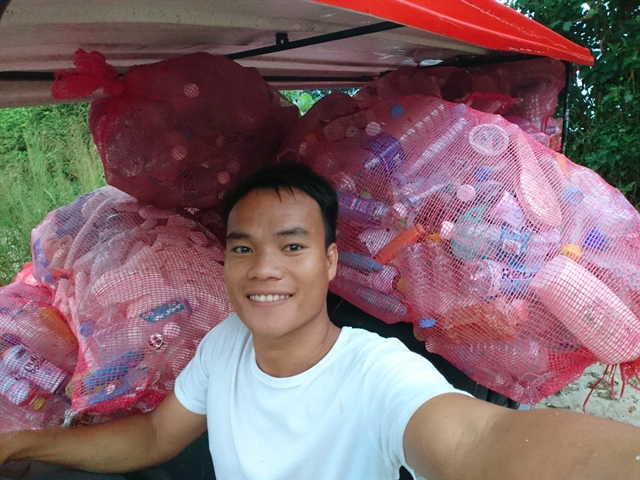ĐÀ NẴNG — Islander Nguyễn Lợi, 29, has built his first house from 6,000 recycled plastic bottles on An Bình islet, three miles from Lý Sơn Island of the central province Đà Nẵng to promote waste reduction and recycling on tourism islands.
Lợi, who studied at HCM City’s Technology College, returned to his hometown to make a living from tourism services.
About two months ago, he decided to build the house with the aim of creating a unique home-stay service for tourists and encouraging locals and tourists to save natural resources and water.
“Plastic bottles are commonly used by local islanders because the islet often faces water shortages in summer. I was able to find plastic bottles everywhere on the islet, including dustbins, beaches, rocks and household trash,” Lợi said.
“I want to send a message to everyone that we need to recycle water and plastic bottles and plastic ware instead of disposing of waste in the environment and sea,” he said.
He spent about (VNĐ40 million, or US$1,700) to build the house on 15sq.m, which was twice the amount spent to build a brick house.
He explained that small plastic bottles (500ml) were sorted out for wall making, while the bigger (1.5l) bottles were used to create vegetable pots, fences or gates.
“I had to fill up plastic bottles with dried sand to make the so-called 'bricks'. Mortar helps the bottles stick to walls and beams. I opt for the thatched roof option in order to help cool the house in summer,” he added.
Loi hopes tourists will stay at the house and help spread the message of environmental protection and keep the ocean free of plastic waste.
The house will open for tourists next month. The homestay will be part of a zero-waste campaign among local residents and visitors to the islet.
Lợi also uses a battery-operated car to transport tourists traveling on the islet.

Islander Nguyễn Lợi, 29, has been building his first house from 6,000 recycled plastic bottles on An Bình islet – 3 miles from Lý Sơn Island, aiming to promote awareness of the need to reduce and recycle waste on the tourism-heavy islands. VNS Photo Thái Hậu
Last year, the International Union for Conservation of Nature (IUCN) launched a communications campaign to promote the non-use of plastic bags as a prelude to its sea turtle conservation programme on Lý Sơn Island.
In 2017, IUCN, in co-operation with the US Fish and Wildlife Service, also started a marine environmental protection communications programme for sea turtle conservation on An Bình Islet.
Paintings of ocean life and species on the walls of households in An Bình Islet call on local islanders and tourists to join hands to protect the marine environment and sea turtles.
IUCN's research found that the sea turtle population in central coastal areas had seriously declined in recent years.
In the 1980s, Quảng Ngãi beaches and Lý Sơn Island often saw about 200 sea turtles approach beaches to lay their eggs.
But the figure dropped by 90 per cent between 1980 and 2000 due to rapid urbanisation, over-fishing and the construction of buildings and concrete dykes.
An initiative called "Refill, Not Landfill", also started by IUCN, encouraged hotel owners and tour operators to provide free drinking water for tourists on Lý Sơn Island.
The programme also spread the message "Down One bottle, Save the Future", to reduce the use of single-use plastic bags and free the ocean from plastic waste pollution.
Lý Sơn Island, 30km off the coast of central Quảng Ngãi Province, is a favourite eco-tour site with more than 200,000 tourists visiting each year.
The island has 109 hotels and guesthouses and 56 home-stays with a total of 650 rooms. They can provide accommodations for more than 1,000 tourists a day.
Lý Sơn Island, as well as a vast coastal area in the districts of Bình Sơn, Trà Bồng, Ba Tơ, Sa Huỳnh and Nghĩa Hành, and Quảng Ngãi city covering 2,000sq.km, are being considered for a designation as a Global Geo-Park by UNESCO.
Lý Sơn Island, known as the "Kingdom of Garlic", has around 21,000 residents, 73 per cent of whom make their living from farming garlic and spring onions, and fishing. — VNS